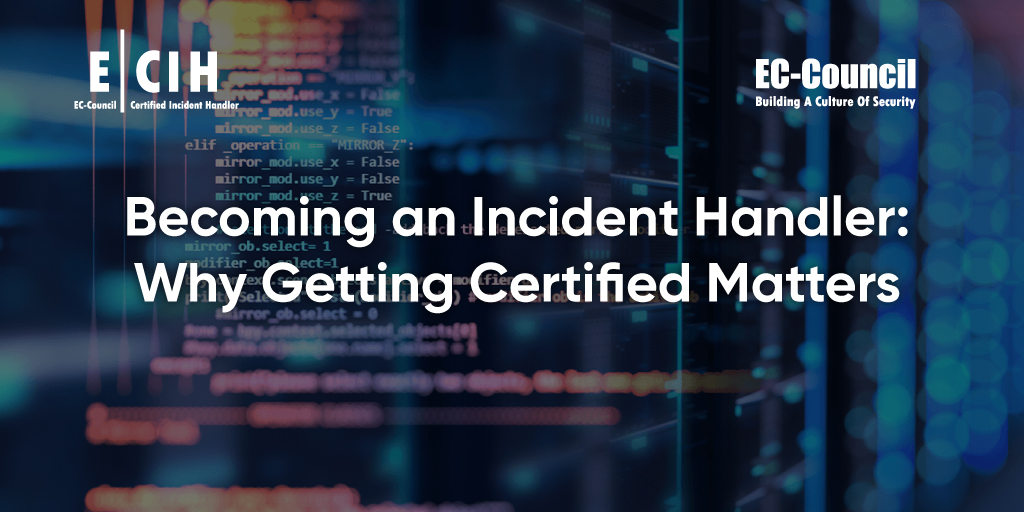When something goes wrong with a company’s IT infrastructure, having the right plan in place for how to handle it is crucial. This is where incident management comes in.
Incident management is the process of identifying, responding to, and resolving security events that affect a company’s IT systems. To ensure that an organization has the best possible chance of recovering from a security incident quickly and efficiently, it’s important to have certified incident handlers on staff.
In this article, we’ll explain the incident management and response process and discuss why certifications like EC-Council’s Certified Incident Handler (E|CIH) matter in the field of incident response. We’ll also look at the five stages of incident management and how to gain the skills needed to successfully navigate them.
What Is Incident Management?
Incident management is a step-by-step process that enables an organization to detect, react to, and recover from incidents that occur within its IT infrastructure. The goal of incident management is to minimize a security incident’s impact on business operations. An incident response plan is a key component of incident management.
The Five Stages of the Incident Management Process
There are five stages in the incident management process:
- Identification
- Containment
- Eradication
- Recovery
- Prevention
At each stage, specific goals and tasks need to be completed to resolve the incident. To successfully navigate these stages, it’s key to have certified incident handlers on staff (Ellis, n.d.).
1. Identification
The identification stage is when the incident is first identified. It’s helpful to have a process in place for identifying incidents quickly and efficiently to ensure incidents are resolved as fast as possible.
2. Containment
In the containment stage, the security team takes steps to stop the incident from spreading and causing further damage. It’s vital to contain the incident so that it doesn’t cause more harm than necessary.
3. Eradication
In the eradication stage, incident handlers take steps to eliminate the cause of the breach. This stage is often referred to as the “fix” phase. The main goal is to eradicate the reason that the incident occurred so that similar events don’t happen again.
4. Recovery
The recovery stage involves restoring the organization’s systems to their pre-incident state. This stage can be time consuming and costly, so having a plan in place for recovering quickly is ideal.
5. Prevention
In the prevention stage, organization members take steps to prevent future incidents from happening. This stage is often referred to as the “mitigation” phase. It’s important to take steps to prevent future incidents from happening in order to minimize damage and strengthen the organization’s security posture.
The Role of Certified Incident Handlers
To successfully navigate these stages of the incident management process, it’s a good idea to have certified incident handlers on staff. Certification programs can provide incident handlers with the knowledge they need to understand the incident management process and what a well-handled incident response looks like. These programs also provide incident handlers with the skills necessary to handle critical security situations effectively and efficiently (Atlassian, n.d.).
What Is an Incident Response Plan, and What Does It Look Like?
An incident response plan is a document that outlines how a company will respond to incidents that occur within its IT infrastructure. Having a well-defined incident response plan is valuable because it ensures that an organization’s security team can quickly and efficiently resolve security incidents (Tunggal, 2021).
To create an incident response plan, security teams need to answer the following questions:
- What are the steps involved in resolving an incident?
- Who will be responsible for completing each step?
- What resources are needed to resolve an incident?
- How will the organization communicate with impacted employees or customers?
- What is the process for escalating incidents?
It’s also a good idea for organizations to test their incident response plans regularly to ensure that they work as intended (Tunggal, 2021).
Transform Your Career with an Incident Handling Certification
Certifications can help incident handlers improve their skills and knowledge and are a great way for cybersecurity professionals to demonstrate their expertise in incident management. Certifications can help incident handlers:
- Better understand the incident management process
- Learn how to successfully and efficiently deal with serious security incidents
- Gain access to resources that can help them resolve incidents more quickly
- Validate their knowledge and experience in incident management
If you want to further your career in incident response, check out EC-Council’s E|CIH program.
Improve Incident Response with the E|CIH Certification
EC-Council’s E|CIH certification program is designed to help incident handlers improve their skills and knowledge in incident management. The program equips incident handlers with the training needed to effectively manage urgent security situations. It also gives cybersecurity professionals access to extensive resources that they can use to improve their incident management skills, including:
- Expert instructors who are highly trained in incident handling
- Online content, including video tutorials and hands-on exercises
- A digital learning portal where students can review course materials at any time from anywhere in the world
- A remote, proctored exam that course participants can take at a time and location of their choosing
The ANSI-accredited E|CIH certification is one of the most highly regarded incident response certifications on the market, making it an ideal way for cybersecurity professionals to demonstrate their expertise in incident handling and management.
The importance of being certified as an incident handler cannot be overemphasized. As cybercrime increases, so does the need for qualified individuals who can properly respond to and mitigate security incidents.
Ready to improve your incident response skills and knowledge? Get started on the path to earning your incident handler certification with EC-Council’s E|CIH. Together, we can make a difference in keeping networks safe from cyberthreats.
References
Atlassian. (n.d.). Get to know the incident response lifecycle. Incident Management. https://www.atlassian.com/incident-management/incident-response/lifecycle
Ellis, D. (n.d.). 6 phases in the incident response plan. SecurityMetrics. https://www.securitymetrics.com/blog/6-phases-incident-response-plan
Tunggal, A. T. (2021, November 9). What is an incident response plan? UpGuard. https://www.upguard.com/blog/incident-response-plan









